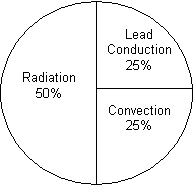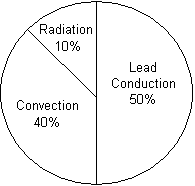The primary failure modes of resistors are open
circuits and resistance drift. The relative probability of each depends on the
application. For example, a resistor used in an application demanding high
precision will naturally be more prone to failure due to
Table
1. Normalized Failure Mode
Distributions for Resistors [1]
|
Resistor Style
|
Relative Failure Mode
Probability
|
|
|
Open
|
Parameter
Change
|
Short
|
Erratic
Output
|
|
Fixed, Film
|
50%
|
45%
|
5%
|
|
|
Network
|
80%
|
|
20%
|
|
|
Fixed, Wirewound (all styles)
|
65%
|
26%
|
9%
|
|
|
Variable (all styles)
|
53%
|
|
7%
|
40%
|
drift/aging affects. Failure mode also depends on the
resistor style. As a rule, film styles are most susceptible to resistance drift
while wirewounds usually fail in the open circuit mode. Resistors failing in the
short circuit mode are rare and only accounting for 3 to 9% of all resistor
failures. A summary of the failure modes of different resistor styles is given
in Table 1.
 |
 |
| Resistors Above 2 Watts |
Resistors 2 Watts and
Below |
Figure 1. Heat Dissipation
of Resistors under Room Conditions
The source of resistor failures is generally due to
outside environmental factors such as handling damage or external stress. High
vibration or shock can also degrade the interface for large mass resistors.
Failures seldom occur due to a failure of the resistive element itself. The only
exception to this rule is the thin film resistor styles that are susceptible to
Electrostatic Discharge (ESD) damage.
The failure modes of variable resistors are
substantially different because they have moving parts and are not as well
sealed against the outside environment. They fail most commonly in the open
circuit mode, and the failure is usually caused by wear of the wiper arm
mechanism. Resistance drift and excess noise can also be a problem as the wiper
arm ages. The short circuit failure mode is again unlikely for variable
resistors.
Failures of all resistor styles are most
commonly propagated by heat. Therefore, it is important to properly understand
resistor heat dissipation properties. The primary heat dissipation mechanism of
a low power resistor is by conduction through its component leads, while a high
power resistor dissipates heat primarily through radiation. Figure 1 portrays the difference for fixed resistors in free air.
[1]Failure mode data was taken from a combination of resistor
manufacturer's recommendations, MIL-HDBK-978, "NASA Parts Application Handbook,"
1991; MIL-HDBK-338, "Electronic Reliability Design Handbook," 1994; "Reliability
Toolkit: Commercial Practices Edition," Reliability Analysis Center (RAC), 1998;
and "Failure Mode, Effects, and Criticality Analysis (FMECA)," RAC,
1993.
Archived
Pages:
Original